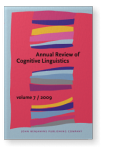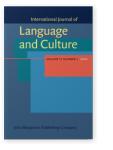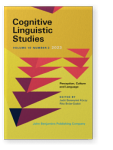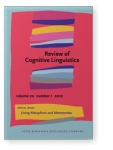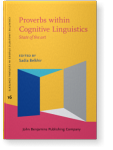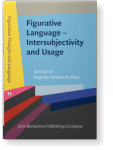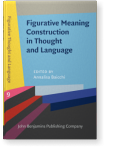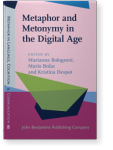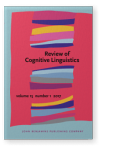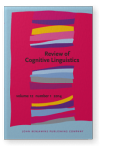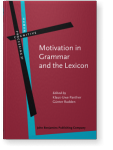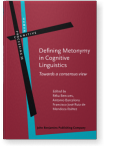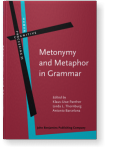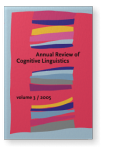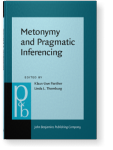Rita Brdar-Szabó
List of John Benjamins publications for which Rita Brdar-Szabó plays a role.
Yearbook
Journal
ISSN 2214-3157 | E-ISSN 2214-3165
Titles
Perception, Culture and Language
Edited by Judit Baranyiné Kóczy and Rita Brdar-Szabó
Special issue of Cognitive Linguistic Studies 10:2 (2023) vi, 239 pp.
Subjects Cognition and language | Cognitive linguistics | Cognitive psychology | Neurolinguistics | Psycholinguistics
Figurative Thought and Language in Action
Edited by Mario Brdar and Rita Brdar-Szabó
[Figurative Thought and Language, 16] 2022. vi, 287 pp.
Subjects Cognition and language | Theoretical linguistics
Living Metaphors and Metonymies
Edited by Mario Brdar and Rita Brdar-Szabó
Special issue of Review of Cognitive Linguistics 20:1 (2022) vi, 304 pp.
Subjects Cognition and language | Cognitive linguistics
2024 Chapter 2. Metonymic layers in proverbs: A cross-linguistic and cross-cultural view Proverbs within Cognitive Linguistics: State of the art, Belkhir, Sadia (ed.), pp. 40–64 | Chapter
Metonymy can be manifest at several levels in proverbs. In this chapter, we identify five such metonymic layers. We first examine whole proverbs as instances of the specific-for-generic metonymy. Secondly, proverbs can be seen as indirect speech acts in which an element of a speech act scenario… read more
2023 Introduction: Perception, culture and language Perception, Culture and Language, Baranyiné Kóczy, Judit and Rita Brdar-Szabó (eds.), pp. 259–269 | Introduction
2023 Cultural models mediating between visual sensation and semiotic systems, exemplified on visual, alpha-pictorial and verbal-gestural communication Perception, Culture and Language, Baranyiné Kóczy, Judit and Rita Brdar-Szabó (eds.), pp. 367–397 | Article
People often see what they want to see (or hear, or taste, etc.), i.e., our mind imperceptibly edits our actual sensations. Culture may function, metaphorically speaking, as a pair of glasses that filters light, because it may be tinted, or have different lenses. In this article we study how… read more
2022 Living metaphors and metonymies Living Metaphors and Metonymies, Brdar, Mario and Rita Brdar-Szabó (eds.), pp. 1–6 | Introduction
2022 Targetting metonymic targets Figurative Thought and Language in Action, Brdar, Mario and Rita Brdar-Szabó (eds.), pp. 59–86 | Chapter
In this chapter we propose to treat metonymy as a cognitive operation of conceptual elaboration based on the part-whole relationship that is triggered by the use of an expression (or metonymic vehicle) associated with a certain conceptual cluster (or metonymic source) within a conceptual domain.… read more
2022 Figurative thought and language research in the 21st century: Back to the future Figurative Thought and Language in Action, Brdar, Mario and Rita Brdar-Szabó (eds.), pp. 1–16 | Chapter
2022 Rosie the Riveter of the COVID time: A case study on figurative intervisuality Living Metaphors and Metonymies, Brdar, Mario and Rita Brdar-Szabó (eds.), pp. 258–289 | Article
Cyclic repetition can be observed in the use of figurative elements in the conceptualization of the coronavirus crisis, involving visual intertextuality or intervisuality. An example is provided by Rosie the Riveter, an iconic image from WW2, which has become extremely popular in recent times.… read more
2022 Metonymy in multimodal discourse, or: How metonymies get piggybacked across modalities by other metonymies and metaphors Figurativity and Human Ecology, Bagasheva, Alexandra, Bozhil Hristov and Nelly Tincheva (eds.), pp. 209–249 | Chapter
One of the most intriguing open issues in metonymy research is the nature of metonymies that transcend or do not appear in spoken/written language. More specifically, we should clarify the issue of whether there exist genuine multimodal (or polysemiotic) metonymies, parallel to multimodal… read more
2021 Metonymic indeterminacy and metalepsis: Getting two (or more) targets for the price of one vehicle Figurative Language – Intersubjectivity and Usage, Soares da Silva, Augusto (ed.), pp. 175–212 | Chapter
Given appropriate context, indeterminacy may arise when a metonymic vehicle, i.e. the source, can be simultaneously linked to more than one metonymic target. We claim that this situation, akin to the phenomenon of metalepsis or transgression in narratology, is not rare, but quite usual, and even… read more
2020 Separating (non-)figurative weeds from wheat Figurative Meaning Construction in Thought and Language, Baicchi, Annalisa (ed.), pp. 45–70 | Chapter
While approaches developed to recognize figurative expressions in discourse widely differ with respect to their formalization, most of them aim for the identification of the figurativeness as directly as possible. There is, however, another promising starting point – to turn our back to… read more
2019 Chapter 9. Metaphor repositories and cross-linguistic comparison: Ontological eggs and chickens Metaphor and Metonymy in the Digital Age: Theory and methods for building repositories of figurative language, Bolognesi, Marianna, Mario Brdar and Kristina Š. Despot (eds.), pp. 225–252 | Chapter
This chapter focuses on the relationship between repositories of figurative speech, cross-linguistic research and ontology models. We first demonstrate on two case studies some problems caused by cross-linguistic comparison of some conceptual metaphors and claim that the interaction between… read more
2017 Chapter 5. How metonymy and grammar interact: Some effects and constraints in a cross-linguistic perspective Studies in Figurative Thought and Language, Athanasiadou, Angeliki (ed.), pp. 125–149 | Chapter
It is often assumed that the relationship between metonymy and grammar is one-way traffic. By applying a cross-linguistic perspective in studying the relationship between grammar and metonymy to the example of so-called embellished clippings and local genitive constructions… read more
2017 On constructional blocking of metonymies: A cross-linguistic view Review of Cognitive Linguistics 15:1, pp. 183–223 | Article
The interaction between metonymy and grammar is commonly understood, in keeping with the classical cognitive linguistic doctrine about cognitive operations motivating linguistic structures, as unilateral – conceptual metaphor and metonymy shaping the grammatical system. However, we argue in this… read more
2017 Chapter 3. Doing Tsukahara and the Epley in a cross-linguistic perspective Constructing Families of Constructions: Analytical perspectives and theoretical challenges, Ruiz de Mendoza Ibáñez, Francisco José, Alba Luzondo Oyón and Paula Pérez-Sobrino (eds.), pp. 77–107 | Chapter
This chapter studies eponymous verb constructions (EVCs) in medical and sports discourse in English, German, Croatian and Hungarian. These are constructions consisting of a light verb such as to do and an eponymic noun phrase denoting events. A cross-linguistic comparison reveals that, unlike in… read more
2014 In search of motivation in language: An interview with Klaus-Uwe Panther Review of Cognitive Linguistics 12:1, pp. 223–242 | Article
2011 Metonymy, metaphor and the “weekend frame of mind”: Towards motivating the micro-variation in the use of one type of metonymy Motivation in Grammar and the Lexicon, Panther, Klaus-Uwe and Günter Radden (eds.), pp. 233–250 | Article
A series of corpus-based case studies on the availability of metonymically used proper names in the language of media, where the name of a capital is used to refer indirectly to the government, shows that this particular type of metonymy is available in Hungarian and Croatian but underused in… read more
2011 What do metonymic chains reveal about the nature of metonymy? Defining Metonymy in Cognitive Linguistics: Towards a consensus view, Benczes, Réka, Antonio Barcelona and Francisco José Ruiz de Mendoza Ibáñez (eds.), pp. 217–248 | Article
The central issue that concerns us in this chapter is whether metonymy should be conceived as a mapping. The way metonymies function in authentic discourse indicates that we have two-way traffic. The initial conceptual substrate is designated by the source concept, but it is plastic and flexible… read more
2009 The (non-)metonymic use of place names in English, German, Hungarian, and Croatian Metonymy and Metaphor in Grammar, Panther, Klaus-Uwe, Linda L. Thornburg and Antonio Barcelona (eds.), pp. 229–257 | Article
2009 Metonymy in indirect directives: Stand-alone conditionals in English, German, Hungarian, and Croatian Metonymy and Metaphor in Grammar, Panther, Klaus-Uwe, Linda L. Thornburg and Antonio Barcelona (eds.), pp. 323–336 | Article
2007 When Zidane is not simply Zidane, and Bill Gates is not just Bill Gates: Some thoughts on the construction of metaphtonymic meanings of proper names Aspects of Meaning Construction, Radden, Günter, Klaus-Michael Köpcke, Thomas Berg and Peter Siemund (eds.), pp. 125–142 | Article
The present chapter deals with the problem of the construction of meaning of figuratively used personal names in the basic constructional schema Det + Xpersonal name + of Y. After a brief overview of two currently dominant philosophical approaches to problems of reference that are at odds with… read more
2005 Feyaerts, Kurt, (Ed.). (2003). The Bible through metaphor and translation: A cognitive semantic perspective Annual Review of Cognitive Linguistics: Volume 3, Ruiz de Mendoza Ibáñez, Francisco José (ed.), pp. 348–354 | Miscellaneous
2003 Metonymic coding of linguistic action in English, Croatian and Hungarian Metonymy and Pragmatic Inferencing, Panther, Klaus-Uwe and Linda L. Thornburg (eds.), pp. 241–266 | Article
